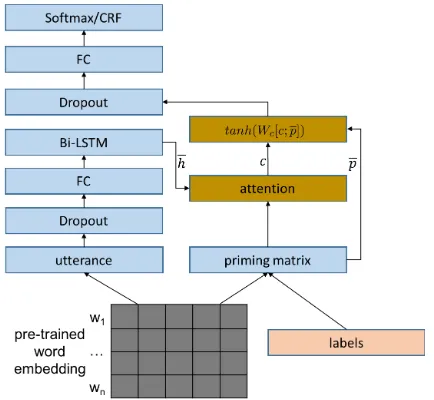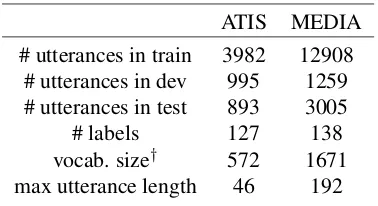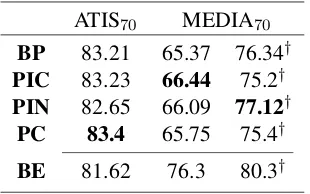22
Attention-based Semantic Priming for Slot-filling
Jiewen Wu1,2,Rafael E. Banchs2, Luis Fernando D’Haro2,
Pavitra Krishnaswamy2, and Nancy Chen2
1A*STAR AI Initiative, Singapore
2Institute for Infocomm Research, A*STAR, Singapore
{wujw, rembanchs, luisdhe, pavitrak, nfychen}@i2r.a-star.edu.sg
Abstract
The problem of sequence labelling in lan-guage understanding would benefit from approaches inspired by semantic priming phenomena. We propose that an attention-based RNN architecture can be used to simulate semantic priming for sequence labelling. Specifically, we employ pre-trained word embeddings to characterize the semantic relationship between utter-ances and labels. We validate the approach using varying sizes of the ATIS and ME-DIA datasets, and show up to 1.4-1.9% improvement in F1 score. The developed framework can enable more explainable and generalizable spoken language under-standing systems.
1 Introduction
Priming (Waltz and Pollack,1985) is a cognitive mechanism in which a primary stimulus (i.e. the prime) influences the response to a subsequent stimulus (i.e. the target) in an implicit and in-tuitive manner. In the case of semantic priming, both the prime and the target typically belong to the same semantic category. Semantic priming can be explained in terms of induced activation in associative neural networks (McClelland and Rogers, 2003). Further, there is empirical evi-dence to suggest that the processing of words in natural language is influenced by preceding words that are semantically related (Foss,1982). There-fore, semantic priming approaches would enable improvements in sequence labelling.
Previous studies have leveraged contextual in-formation in utterance sequences (Mesnil et al.,
2015) and dependencies between labels (Ma and Hovy,2016) to improve performance in sequence labelling tasks. However, there is limited work to use contextual information in utterances to inform
inference of the subsequent labels through seman-tic priming. For instance, “I’d like to book ...” not only suggests the next word(s), e.g., flight, but also the label of the next word(s), e.g., services. We posit that systems employing this mode of cross-linked semantic priming could enhance per-formance in a variety of sequence labelling tasks.
In this work, we hypothesize that semantic priming in human cognition can be simulated by means of an attention mechanism that uses word context to enhance the discriminating power of se-quence labelling models. We propose and explore the use of attention (Bahdanau et al., 2014) in a deep learning architecture to simulate the semantic priming mechanism. We apply this concept to slot filling, an example of sequence labelling in spo-ken language understanding, which aims to label the utterance sequences with a set of begin/in/out (BIO) tags. Specifically, we use pre-trained word embeddings to characterise not only the context of words, but also the semantic relationship between words in utterances and words in labels.
Overall, we develop a semantic priming based approach for the task of slot-filling to associate ut-terances and label sequences. Our contributions are as follows: (1) We propose an approach that applies semantic priming to sequence labelling. To capture semantic associations between utter-ance words and label words, we use three differ-ent strategies for deriving label embeddings from pre-trained embeddings. (2) We implemented the approach in an LSTM-based architecture and val-idate the efficacy of the approach.
In Section2we review related work. Section3
elaborates the proposed approach. An empirical evaluation is provided in Section4. Finally, Sec-tion5concludes the paper.
2 Related Work
sequence-based NLP tasks, particularly, machine translation (Bahdanau et al., 2014;Luong et al.,
2015). Since attention allows the neural networks to dynamically attend to important features in the inputs, it is a suitable mechanism to achieve the objective of semantic priming between utterances and labels. Conditional random field (CRF) has been used together with RNNs, sometimes also in-cluding CNNs, to improve accuracy (Mesnil et al.,
2013, 2015; Ma and Hovy, 2016; Reimers and Gurevych,2017b).Dinarelli et al.(2017) proposes to learn label embedding for improving tagging accuracy, while our label embedding is computed directly from pre-trained word embeddings. Fur-thermore, our approach does not require shifted la-bel sequences as input.
To use external knowledge, previous studies consider graph or entity embedding (Huang et al.,
2017;Chen et al.,2016;Yang and Mitchell,2017), together with other contextual information, such as dependency graph (Huang et al.,2017) or sen-tence structures (Chen et al.,2016). Specifically,
Yang and Mitchell (2017) extends LSTM with graph embedding to learn concepts from knowl-edge bases and integrate the concept embedding into the state vectors of words. In contrast, our approach does not learn or parse sentences to get extra contextual information, which is suitable for languages lacking well trained parsers. Moreover, context integration is achieved without fine-tuning the underlying RNN structure yet rather through the attention mechanism.
3 Semantic Priming
Figure1 depicts an LSTM-based neural network architecture for semantic priming. Given an ut-terance, a priming matrix is computed to con-nect the labels to input features generated by a bi-directional LSTM. The priming effects are then used for prediction.
3.1 Computing Priming Matrix
This section considers three different strategies of the proposed attention-based semantic priming mechanism. In all the three cases the input words are compared to proxies of the semantic categories over word vectors.
Let m denote the number of labels. An ut-terance of length n is represented by the matrix
X:n×k, wherekis the dimension of pre-trained word vectors. Given a word vectorxj, semantic
priming is achieved by comparingxj with a label
embedding matrixL:m0×k, withm0unique
con-Figure 1: Proposed topology for priming. FC de-notes a fully connected layer.
cepts, each encoded inkdimensions. In addition, let Eli,1≤i≤m0 denote the set of embedded words tagged with the label li in the dataset. Note that
the corresponding embedding of li is Li. Below
are the definitions of three different strategies to compute the label embeddingsL.
• Priming using Instance Centroid (PIC): Lis defined to bem×kandLi = mean(Eli). Intuitively, the proxy of the concept, Li, is
the centroid (mean vector) of the cluster of all known instance words in the concept.
• Priming using Instance Neighbor (PIN):Lis defined to bem×kand
Li = argmin ∀e∈Eli
(1−cos(xj, e))
In this case, the proxy of the concept is the nearest instance having the same label asxj. • Priming using Concepts (PC):Lis defined to
bem0×k,m0is pre-specified, andLi =ci,
whereciis a manually selected concept from
li. The embedding representation, ci, is of
dimensionkas it is either the word vector per se of a single concept label or the mean vector of a set of such word vectors.
WhilePIN is a straightforward simulation of the semantic priming mechanism between a prime and its potential targets in different classes, PIC and
[image:2.595.310.527.61.261.2]ATIS MEDIA # utterances in train 3982 12908
[image:3.595.87.276.61.164.2]# utterances in dev 995 1259 # utterances in test 893 3005 # labels 127 138 vocab. size† 572 1671 max utterance length 46 192
Table 1: Statistics of datasets. †The vocabulary is a mix of words and entities.
OnceLis computed, the priming matrix is com-puted by the cosine similarity, or the induced dis-tance, between the word embedding of the utter-ance andL, i.e.,p=cos(X, L).
3.2 Attention to Semantic Priming
In Figure 1, the hidden states, h, of the bi-directional LSTM are considered to be the source, while the priming matrixpis analogous to the tar-get. Following (Luong et al.,2015), we define the alignment scoring function to bes(p, h) = pWah
and compute the final output as follows:
α= Pnexp(s(p, h))
i=1exp(s(p, hi))
c=X
h
αh
t=tanh(Wc[c;p])
4 Experiments
To validate the efficacy of the architecture in Fig-ure1, an empirical evaluation was performed and implemented in Keras1. This section elaborates the experimental setup and presents our results.
4.1 Datasets
Two datasets on spoken dialogues were used in the experiments, namely, the Air Travel Infor-mation System (ATIS) task (Dahl et al., 1994) and MEDIA, French dialogues collected by ELDA (Bonneau-Maynard et al.,2005). The statistics of the two datasets is given in Table 1. For ME-DIA, using entities significantly impacts the per-formance. Thus entities are used together with words in utterances, as implied by the size of vo-cabulary in Table 1. Since bi-directional LSTM is used in the architecture in Figure1, no context word windows (Mesnil et al.,2015) were used as additional inputs in the datasets. The pre-trained
1https://keras.io/
word embedding sources for the two datasets are GloVe (English) (Pennington et al.,2014) and fast-Text (French) (Bojanowski et al., 2016), respec-tively. In particular, we found that there are about 100 words missing in the fastText French word embedding. Some of the words, however, are due to original tokenization in MEDIA.
4.2 Setup and Hyperparameters
To facilitate mini-batching for training, the ut-terances were padded to the maximum utterance length. For all experiments, we use one set of fixed hyperparameters to enable meaingful com-parison. The dimension of word embedding is 300 for both GloVe and fastText. Following the recom-mendations in (Reimers and Gurevych,2017a), all dropout layers have a rate of 0.5, and LSTM has an additional recurrent dropout of 0.5 between re-current units. During learning phase, a mini-batch size of 18 and an initial learning rate of 0.004 was used with the Adam optimizer to minimize the cross-entropy loss. The learning rate was reduced by 50% after no improvement in three epochs.
As semantic priming provides connections be-tween words and labels through the use of the same pre-training embedding, it will enable more robust performance even when the datasets are small. To validate this, we investigated the effects of semantic priming in cases where the datasets are reduced. Note that both ATIS and MEDIA have many short utterances; in particular, ME-DIA has over 4000 utterances consisting of a sin-gle word. For reduction, we rank vocabulary by word frequency in the training and development sets and choose utterances containing the words until 100% of vocabulary is covered.
4.3 Results
In this section the conlleval-F12 scores are re-ported. The experiments were run on a NVIDIA DGX1 station (Tesla V100 and 16GB memory), and the F1 scores are the average of that in the first 30 epochs in three independent runs.
The results shown are for baseline with train-able embedding (BE), baseline with pre-trained embedding (BP), and the strategies defined in Sec-tion3.1, i.e.,PIC,PINandPC. ForPC, the con-cepts are the keywords that have occurred in the labels. Example concepts includeairlinein ATIS andchambrein MEDIA. A total of 30 and 53 con-cepts are extracted for PCin ATIS and MEDIA, respectively.
AlthoughBEyields much higher F1, we com-pare the proposed approach with the baseline ap-proach, BP, where F1 is computed using pre-trained embedding. This is because all strategies, except forBE, are based on pre-trained word em-bedding. We also compare the results in the ME-DIA dataset with and without CRF. Since CRF in ATIS was shown to lead to no improvement (Dinarelli et al.,2017), so, no CRF layer was ap-plied to ATIS in the experiments.
ATIS MEDIA
BP 94.22 72.66 79.46†
PIC 94.23 69.37 80.49†
PIN 94.41 69.79 80.56†
PC 94.51 72.55 78.35†
[image:4.595.340.495.100.197.2]BE 94.75 82.16 86.38†
Table 2: F1 of the two datasets. †CRF used. Table 2 shows the F1 computed over the full datasets. In ATIS, although no significant con-clusions can be drawn, all strategies, in particular,
PC, outperform the baselineBP. Note that, when CRF, instead of SOFTMAX, is used in MEDIA, there is an increase of 4% forBE, 7% forBP, and 10% forPIC/PIN. For MEDIA, F1 has a consid-erable drop when pre-trained word embedding is used instead of trainable embedding. When SOFT -MAX is used, none of the strategies outperformed the baselinesBPorBE. In contrast, once CRF is used bothPIC andPIN gained over 1% increase compared withBP.
ATIS100 MEDIA100 BP 85.39 67.64 76.95†
PIC 87.25 66.84 76.81†
PIN 86.31 68.25 78.34† PC 87.01 67.37 77.95†
[image:4.595.110.254.206.302.2]BE 86.04 78.81 83.77†
Table 3: F1 of the reduced datasets. †CRF used. 100% of the vocabulary in datasets are retained.
Table 3 describes the results over reduced datasets that cover the full (100%) vocabulary in the datasets. ATIS100 has a total of 583
utter-ances for training/development, while MEDIA100
has 1717 for training/development. Note that re-duction wasnotperformed to test datasets, i.e., full test sets were used. For both ATIS and MEDIA,
PIN shows consistent performance gain (+1%) over the pre-trained baseline approach (BP).
ATIS70 MEDIA70 BP 83.21 65.37 76.34†
PIC 83.23 66.44 75.2†
PIN 82.65 66.09 77.12† PC 83.4 65.75 75.4†
BE 81.62 76.3 80.3†
Table 4: F1 of the reduced datasets. †CRF used. 70% of the vocabulary in datasets are retained.
Table 4 describes the results over further re-duced datasets, i.e., these two rere-duced datasets covers only 70%3 of the whole vocabulary, con-taining 348 and 1216 utterances (train/dev) for ATIS and MEDIA, respectively. As shown in Ta-ble4,PCwas the best strategy for ATIS whilePIN
consistently outperformed the baselineBPin ME-DIA.
Overall, we have seen performance gains when priming is used over the original and reduced datasets, compared to the pre-trained baseline ap-proachBP. In particular, we recommendPINover the other strategies as it is less computational ex-pensive compared withPICwhile it seems to pro-vide more consistent improvement over BP than other strategies.
5 Conclusions and Future Work
We have demonstrated an approach to leverage se-mantic priming for natural language understand-ing tasks. The approach employs pre-trained em-beddings to prime label concepts based on utter-ance words. Our experimental results suggest im-provements over baselines are feasible. However, we note that the coverage of the dataset vocabulary in the pre-trained word embedding may limit per-formance improvements. For example, the miss-ing words in the pre-trained French word embed-ding adversely affected the F1 scores for MEDIA. The approach can be easily adapted to a variety of different network architectures (e.g., (Dinarelli et al.,2017)) and word embeddings (e.g., (Reimers and Gurevych,2017a)). Future studies will focus on how to choose a good set of concepts for the PC priming strategy. It will also be fruitful to under-stand how to explain the sequence labelling out-puts using attention mechanisms.
3
[image:4.595.104.261.524.620.2]References
Dzmitry Bahdanau, Kyunghyun Cho, and Yoshua Bengio. 2014. Neural machine translation by jointly learning to align and translate. CoRR, abs/1409.0473.
Piotr Bojanowski, Edouard Grave, Armand Joulin, and Tomas Mikolov. 2016. Enriching word vec-tors with subword information. arXiv preprint
arXiv:1607.04606.
Helene Bonneau-Maynard, Sophie Rosset, Christelle Ayache, A Kuhn, and Djamel Mostefa. 2005. Se-mantic annotation of the french media dialog corpus.
Yun-Nung Chen, Dilek Z. Hakkani-T¨ur, G¨okhan T¨ur, Asli C¸ elikyilmaz, Jianfeng Gao, and Li Deng. 2016.
Knowledge as a teacher: Knowledge-guided struc-tural attention networks.CoRR, abs/1609.03286.
Deborah A. Dahl, Madeleine Bates, Michael Brown, William Fisher, Kate Hunicke-Smith, David Pallett, Christine Pao, Alexander Rudnicky, and Elizabeth Shriberg. 1994. Expanding the scope of the atis task: The atis-3 corpus. InProceedings of the
Work-shop on Human Language Technology, HLT ’94,
pages 43–48, Stroudsburg, PA, USA. Association for Computational Linguistics.
Marco Dinarelli, Vedran Vukotic, and Christian Ray-mond. 2017. Label-dependency coding in simple recurrent networks for spoken language understand-ing. InINTERSPEECH.
Donald Foss. 1982. A discourse on semantic priming.
Cognitive Psychology, 14:590?607.
Lifu Huang, Avirup Sil, Heng Ji, and Radu Florian. 2017. Improving slot filling performance with atten-tive neural networks on dependency structures. In
EMNLP.
Thang Luong, Hieu Pham, and Christopher D. Man-ning. 2015. Effective approaches to attention-based neural machine translation. InEMNLP.
Xuezhe Ma and Eduard Hovy. 2016. End-to-end se-quence labeling via bi-directional lstm-cnns-crf. In
Proceedings of the 54th Annual Meeting of the As-sociation for Computational Linguistics (Volume 1:
Long Papers), pages 1064–1074, Berlin, Germany.
Association for Computational Linguistics.
James L. McClelland and Timothy T. Rogers. 2003. The parallel distributed processing approach to se-mantic cognition. Nature Reviews Neuroscience, 4:310–322.
Gr´egoire Mesnil, Yann Dauphin, Kaisheng Yao, Yoshua Bengio, Li Deng, Dilek Hakkani-Tur, Xi-aodong He, Larry Heck, Gokhan Tur, Dong Yu, and Geoffrey Zweig. 2015. Using recurrent neural networks for slot filling in spoken language under-standing. Trans. Audio, Speech and Lang. Proc., 23(3):530–539.
Gr´egoire Mesnil, Xiaodong He, Li Deng, and Yoshua Bengio. 2013. Investigation of recurrent-neural-network architectures and learning methods for spo-ken language understanding. InINTERSPEECH.
Jeffrey Pennington, Richard Socher, and Christo-pher D. Manning. 2014. Glove: Global vectors for word representation. InEmpirical Methods in
Nat-ural Language Processing (EMNLP), pages 1532–
1543.
Nils Reimers and Iryna Gurevych. 2017a. Optimal hy-perparameters for deep lstm-networks for sequence labeling tasks.CoRR, abs/1707.06799.
Nils Reimers and Iryna Gurevych. 2017b. Report-ing Score Distributions Makes a Difference: Perfor-mance Study of LSTM-networks for Sequence
Tag-ging. In Proceedings of the 2017 Conference on
Empirical Methods in Natural Language Processing
(EMNLP), pages 338–348, Copenhagen, Denmark.
Eleanor Rosch, Carolyn B Mervis, Wayne D Gray, David M Johnson, and Penny Boyes-Braem. 1976. Basic objects in natural categories. Cognitive
Psy-chology, 8(3):382 – 439.
David L. Waltz and Jordan B. Pollack. 1985. Mas-sively parallel parsing: A strongly interactive model of natural language interpretation. Cognitive Sci-ence, 9(1):51 – 74.


